#reactive app with flutter
Explore tagged Tumblr posts
Text
Dinner Offer: Interlaced Signals - Pt. 2 of ???
Goro bites the bullet and finally contacts Varsha. Is that offer still on the table?
Ao3 || Fic Wiki Hub
1||2(You are here)||3||???
Appox. 3.4k

---------
Noon. Japantown. 19th level. The Market.
Goro was methodically pacing through the bazaar. Tracing the route the parade would take through this section where everything he, no, they had worked so hard to achieve would come together.
Looking up to the balconies and footbridges high above, he accessed that shard they procured from Wakako, and Varsha had kindly duplicated for him. As he scanned the buildings, markers pinged in his sight, where speculated and confirmed locations of Arasaka security had set up for the parade. Increased security.
“Hm.” His eyes drifted from one hidden security location to the next, noticing subtle changes, or people that looked slightly out of place.
His mind was thinking of the most troublesome ones that had to be dealt with or he would be dead before he even touched Hanako’s float. The snipers. He had the trio’s locations confirmed. “Vargus and Višnja will have to work swiftly and stealthily.”
That was his main concern besides the netrunner they would have to subdue and disable the security so he could safely enter the float.
He continued his walk. He made a note here. An updated log there. It was best to jot down anything new or odd. He would share with the others so they could properly prepare.
A few more rounds before he finally took a break. A quick stop at one of the vendors for a fresh cup of coffee(or so they said) and he found a place to rest on a bridge.
Leaning against the railing, he looked up to where that prized float would stop for Hanako’s speech. A multitude of calculations ran through his mind. Calculations concerning that jump he would be making. Would his augments be enough? Could he afford some shock-absorbing gear to be on the safe side? He did have some extra cash to do so.
His fingers tightened around the warm cup for a moment before relaxing.
“All will go well.” He told himself. No need to fret over details like that.
As he sipped on his overly bitter coffee, his eyes wandered around the market.
Workers buzzing about like diligent worker bees. Placing decorations and projectors, checking on ones they placed days earlier, and tidying up the place for the festivities that were coming soon. Amazing how quickly they were transforming the place to be more orderly.
He continued to sip his coffee and people-watch. Something he had been doing more frequently after he had stopped being so stubborn and allowed Varsha and her strange ripperdoc “friend” to partially tamper with and reactivate his disabled cyberware around a month or so of their tentative cooperation. The facial obscuring software allowed him to move around more freely, but he was still cautious. He still had a price on his head.
Shifting the cup to one hand, with the other, he brought out his phone. A quick check. In that “note” app to make sure he wasn’t forgetting anything. Just a few more places to check before he headed back to this hideout. All was good.
As he was about to fully back out of the app, he noticed some other notes. Apology notes.
“Hm.” His nose wrinkled for a moment. With a deep exhale he sighed. He opened it and skimmed through.
“How to apologize to Varsha for my assumption?” He mumbled to himself as he scrolled through half-completed drafts and scattered notes he had been working on ever since he had asked the twins for their help to decipher Varsha’s text.
Mind now cluttered with this issue again, he left his current railing perch for another near a more secluded corner so could come up with something decent to send Varsha.
His fingers fluttered away. He sipped that coffee until it was dry in between typing. Minutes passed.
“No, no, no.” He mumbled as he started his tenth draft. Nothing he wrote felt satisfactory. Was he overthinking things?
It wasn’t long before he stopped and gazed into the distance. Eyes bouncing from one neon advertisement to the next and the cars below.
“Perhaps,” he mumbled as something simple was coming to his mind, “perhaps, I can just check in to see how she is doing? To see if the biochip has grown worse?”
He had sent such cursory checks once he and Varsha were on better terms. And, of course, he needed her and the twins alive.
He nodded to himself. “Yes. Start with that and ease my way into that discussion.”
With newfound confidence, he shot off a text to her. Now he just had to wait. He started his walkabout the market again.
About ten minutes into his scouting, his phone buzzed. He checked it.
[Varsha]: Good afternoon, Takemura. I’ve been doing well despite some interference from a minor Relic malfunction.
A faint smile crossed his face, hearing she was doing well, but it soon disappeared as he read the latter half of her message. How “minor” was it? He was about to reply, but noticed she wasn’t done.
[Varsha]: I’m nearly done finalizing our secured network for the parade, as well as additional facial encryptions and scrambling malware. I’ll have the twins deliver the shard to you once done. How are you?
He found a secluded spot to stop and reply back.
[Takemura]: That is good to hear. And good to hear your health is stable.
And he hoped it would continue to stay that way.
[Takemura]: I am doing well, myself. Currently, I’m going over the plans for the parade. The last rounds of scouting before the night comes.
[Varsha]: How wise. Be cautious. My spiders have picked up increased security in some areas.
[Takemura]: I am always. And I have noticed. I will share the details with the twins.
Looked like she was in a good mood. Now how to brooch that topic?
Goro mulled over his thoughts, thinking of how to start. Before he could even type, she sent another message.
[Varsha]: I heard on the vine the twins roped you into joining a few of their gigs the other day. How did that all fair?
He raised a brow. A chuckle escaped his lips. Of course, they would tell her about that. The three had a close bond. Maybe he should answer this and soften her mood some more?
[Takemura]: Yes. They ‘twisted my arm’ by offering me fair cuts and kept to their word. The ventures were successful.
[Varsha]: Good, good. I don’t think the two would dream of double-crossing you. Now, that is.
A chuckled huff slipped out. Now. Was that a subtle jab or tease? He would take it as the latter. He and the twins were on much better terms than in the beginning. Especially him and Višnja. How fiery she was in the beginning, barely held back by her brother and Varsha. Somedays he wondered how close she was to hacking his cyberware to fry his systems.
[Takemura]: Also, before the night was over, the twins delivered to me your gifts. The meals. One home-cooked and the other from a restaurant?
[Varsha]: Yes. The fish came from Mustique. The chef owes me. The curry dish was made by me. I had extra to share. Didn’t want any going to waste.
“Hm…” He shifted his phone between his fingers. She truly had good taste. Would these have been some of the options she would have offered the night?
[Takemura]: Both were delicious. I could taste the flavors. The real food. All have the correct textures. A nice change of pace from what I’ve had to endure. Thank you for your kindness.
[Varsha]: Glad you liked it. Felt like you could use a change of pace. I’ll pass the compliments on to my friend.
[Takemura]: Thank you… again… I truly mean it.
He tapped his thumbs together. Bite the bullet and bring it up.
[Takemura]: About our conversation that night after the warehouse infiltration.
[Varsha]: Yes?
[Takemura]: I wish to apologize for misinterpreting your offer. I hope I did not offend you.
[Varsha]: No offense was taken. Truthfully, I didn’t notice how you interpreted my offer and just thought you were being your cautious self until Astra, the others, Silverhand, and my roommate pointed it out. Heh, truthfully, I’ve dealt with worse.
Both brows were raised. Really? He had been worrying over nothing.
[Takemura]: You have?
The errant thought slipped through before he realized he sent it. He quickly sent another text.
[Takemura]: Do not answer that. My apologies, again. You don’t have to answer that.
[Varsha]: (o^-’)b
[Takemura]: I do have another question to ask.
[Varsha]: Go ahead.
[Takemura]: Is the dinner offer still available…?
Should he add the next part?
[Takemura]: At your residence?
It wouldn’t hurt. It was worth a shot. He was more comfortable with the more private setting. And wouldn’t mind trying more of her cooking.
[Varsha]: It is. One moment as I sort my thoughts.
Goro took his eyes off his phone for a moment. Shaking his head, a sigh of relief slipped out. How he could overthink things, but so much was on his mind. So much was at stake. Part of him was thankful he didn’t put another dent in his relations with her. He still needed her and the twins for the evidence they had.
It took about a minute before Varsha sent the first flurry of texts. It was a wall of information. She was the detailed sort.
[Varsha]: With our schedules becoming more limited, make yourself free tomorrow evening.
[Varsha]: It won’t be a quiet evening as I will have people over. This may be perceived as a bit morbid to you, but the twins and my dear friend Omar insisted on a preemptive ”goodbye” party, depending on how things go with the parade. This is the best date to squeeze you in. Either way, you’ve met nearly everyone.
As he was reading that, images soon accompanied the next set of texts.
[Varsha]: Omar. My fighter pilot friend you met with me some time ago. He’s told his security detail to “take the night off”, so you won’t be seeing Maddie and Royce.
He recognized the moment in the photo. An unexpected crossing of paths when he and Varsha were doing some work securing additional leads and details concerning Yorinobu and the parade. That jolly Sikh gave Varsha quite the bear hug after spotting her and rushing over. His bodyguards took their sweet time to catch up. Maddie almost seemed embarrassed and Royce was amused, making playful jests at Varsha for not checking her messages.
[Varsha]: Besides them, the twins will be over. As well as Viktor and Misty.
He wasn’t surprised to see that old ripperdoc and the mystic shop owner come up next. Even with their unexpected meeting when he and Varsha were at death’s door, he found them to be pleasant. Trustworthy. Even after Viktor got wind of the finer details of what trouble he was roping his close friends into. It strained their once cordial relationship as Goro noticed the man was oddly short when he would pay a visit for some treatments and the anesthetic wasn’t as “strong”.
The simmering animosity finally came to a head a while ago when Viktor kept him from leaving. They finally talked, though for Goro it felt like more of the similar lecturing he would get from the twins whenever they would poke at his blind loyalty to Arasaka. Yet, part of him was hesitant to admit that maybe there was some truth to their words, even if it was minuscule.
Besides that old-treaded subject, Viktor gave a firm warning. He could vividly remember that evening.
“Whatever you’re planning to do to get to Hanako, don’t get them killed.” Viktor’s voice was still laced with venom, strained with irritation. “Yeah, the twins are still young and dumb, heh, I think we all were at their age…” All the irritation slipped away for a few seconds thinking of folly in his youth, but as quick as it came it slipped back into that serious irritation. “Don’t. Get. Them. Killed. They’re like family to me.”
What happened next caught Goro off guard.
“And for Varsha...” Viktor paused. His shoulders dropped as well as his head, before he shook it. A deep, tired sigh came out. With one hand, he took off his glasses, and with the other, he rubbed his eyes. Seconds passed before he looked at Goro again. He looked so tired. “Varsha… I’ve known her longer than the twins. Even before Jackie… but he’s the reason we actually started talking. A friendship blossomed. She’s Corpo with a strange heart. Hehheheh. Showed a genuine interest in my old boxing days and was never dismissive. Heh.” It was a pained laugh that slipped out as he shook his head. “To think she’s only wrapped up in this mess because she’s got a big heart for those twins… That Relic would have been in Višnja’s head… We should have pushed more to keep them out of that Heist…”
Viktor took a moment to push the hypotheticals out of his mind. Everything was bleak. He slipped those glasses back on before he folded his hands together and pressed his chin against them. “She’s… she’s like a sister to me. Don’t let her sacrifices be for nothing. Best pray that Hanako of yours can be of help and won’t play games.”
That little conversation led to Goro reanalyzing his previous conversations with Varsha, Višnja, and Vargus(as well as any others) he had recorded. The little comments about their lives and personal details he glossed over or ignored if they weren’t relevant at the time. Despite the generation differences and massive gaps in life experiences, the trio had a strong bond. Varsha truly cared for the twins as she mentored them during their early days with Arasaka and secured a “fair” exit for the two after an “incident” and a semi-retirement for herself. She didn’t have to do that. It would have been easier for her to have ignored the inter-division conflict that finally hit the edge that day and let the twins jump headfirst into their graves, but she intervened.
The rumble of his phone and pings drew him from his thoughts. More messages and photos from Varsha.
[Varsha]: Also, Dr. Eli Rothschild and his daughter, Mithra. You remember both of them from that day, yes?
He recognized them. An “old”, bald dark-skinned gentleman rarely seen without those green-lense click-on glasses and a spunky young woman a shade lighter than him with an afro pulled back in a large bun. A father-daughter pair of more “legal” ripperdocs working for a small joint division of two corporations handling some recycling endeavors in the city; the two enjoyed occasionally moonlighting on the more illicit side. He met them around the same time he met Viktor and Misty. The two knew Varsha’s sophisticated cyberware better than Viktor. Goro was in and out of consciousness but recalled the pair came in as Viktor was prepping Varsha for surgery. Dr. Rothschild assisted Viktor while Mithra helped Misty with his treatment.
From his brief meeting with them here and there to their clinic after hours, the two were pleasant. Even with Varsha footing the bill, he sparingly went to the doctor unless Viktor wasn’t available.
[Takemura]: Yes. I do. Their hands are as good as Viktor’s.
[Varsha]: (o^-’)b Good good. I’m still covering all expenses. No need to pay them.
[Varsha]: And lastly, my roommate and cybersecurity. Malik.
The last set of images appeared on his screen. He had seen many things, both with Arasaka and his current time in Night City, but there were still some appearances that could surprise him.
Just from the portrait photos of her roommate, the tan-skin man had extensive top-of-the-line Netrunning cyberware with the number of coolant lines, ports, cables, and vents he saw, as well as some of the cosmetic wear. And there were scars across his face, especially around his eyes that were plated in gold. If they were scars and not entirely a fashion statement.
“I wonder if he’s had a full-body conversion?” Goro mumbled.
[Varsha]: So don’t be surprised if your software picks up an “unauthorized scan” before you arrive. He loves to double-check even with my reassurances.
[Takemura]: Noted.
That wouldn’t be a problem as long as her roommate didn’t attempt to install some trackers or malware.
He was about to send a message asking for the address before another set of pings came in.
[Varsha]: Ah. Nearly forgot. There will be two more. However, I believe neither will take part in tonight’s festivities.
The first image came in. Goro recognized the young lady. A bright-eyed and equally bright blue-haired photographer and “treasure hunter.” Another friend he wondered how Varsha met and became acquainted with. The two walked very different life paths.
[Varsha]: My dear friend Kitt. Do you remember her from that day? She’s still recovering from what the Scavs did to her.
[Varsha]: Thank you, again, for your assistance that evening. You didn’t have to, as the acquisition of those resources was more important, but you did.
[Takemura]: I remember her. You are welcome. How is her recovery going?
[Varsha]: Slow, but well. She’ll most likely be resting that night.
This was one of the events he reanalyzed after his talk with Viktor. Kitt was more than a friend to Varsha. From what he observed, he believed she bordered that familial territory, with Varsha acting rather motherly towards her. It also explained why Varsha detested the Scavs so much. What they did to that girl. It was a miracle she was still alive.
It was a heated evening trading gunfire and quickhacks in a rundown apartment block. Varsha even allowed her more unruly AI companions to run rampant, but they were successful in rescuing her friend, who was in rough shape. Varsha thanked him for his help despite the dangers. In a way, she was still surprised he offered his assistance. Was it out of sympathy or so he didn’t lose an important asset? It didn’t matter. Part of her icy demeanor towards him thawed. She covered all his expenses for the ammunition spent and the visit he would have to pay to Viktor.
[Varsha]: And last but not least, your driver. Package Runner, Otxo.
The last set of images came through.
A biker sat on a Brennan Apollo that had been customized for package running. There was no “face” to the biker as they wore a black helmet that had cat ears. And it was impossible to make out their skin tone with the jumpsuit and jacket they wore. What stood out was a logo on the bike and jacket. 9 Lives Delivery; a stylized tiger trotted along, its tail coiled around a trolley filled with packages.
[Varsha]: They are a highly reliable individual and can be discrete despite their appearance. They are my favorite person to contract for package running.
[Varsha]: Contact them around 19:00 tonight to trade information. They know the backdoor to get into the complex where you won’t be seen.
Goro studied the images a little longer. He didn’t like he couldn’t see their face. But they must have had a good reason to hide it. Package runner. He nodded at that. They most likely handled confidential and illicit goods. A concealed identity would be best for such work.
[Takemura]: Otxo… How does one pronounce that name?
[Varsha]: Per their request, similar to the Spanish word: Ocho.
[Takemura]: Ok. And thank you, once again, for the invitation. I will make sure I arrive on time. Shall I bring anything?
[Varsha]: Pleased to have you coming. You’re welcome to bring whatever, but nothing is needed. Everything from food to drinks is covered.
The conversation came to an end after Goro sent up her information from his latest round scoping out the bazaar.
With that done and a weight lifted from his shoulders, Goro spent some more time scoping out the bazaar before completing some other errands for the day.
On his way home, he stopped at a boutique to buy some more cheap but “formal” clothes and some nice-smelling soap. He was going to make sure he looked presentable for the evening.
Once back at his safe house, he cleared a space for what he purchased, making sure everything stayed clean. He spent the rest of his evening cleaning and shining his boots and jacket as he caught up on the news.
He made sure to contact Oxto around 19:00 to trade information. Their text conversations were short and straight to the point. Tomorrow around 18:05, he would meet them around one of the back alleys to an apartment in Japantown.
With everything set, he finished up for the evening and turned in. He had a few things to prepare for before the dinner party.
#writings#fic writings#cyberpunk 2077#cp2077#goro takemura#Corpo V Trio#OC: Varsha Joshi-Blackbourne#Cyberpunk 2077 fic#Cyberpunk - A Life That Was Designed
3 notes
·
View notes
Text
What is the Best Mobile Application Development Framework, Flutter, or React Native?
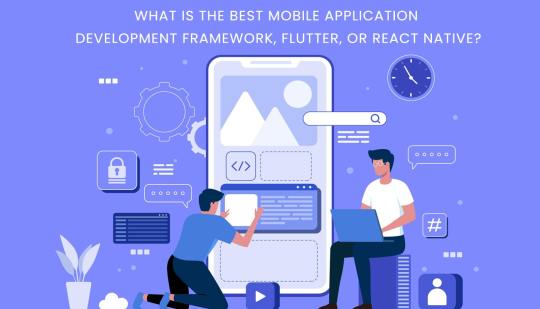
As an ever-increasing number of individuals are accepting modernized innovation in technology, the interest in mobile applications has expanded step by step.
Hybrid mobile frameworks are acquiring prevalence. The presence of React Native (RN) in 2015 opened astounding chances to assemble applications for iOS and Android utilizing one codebase. Thus, it permitted us to solve two problems at once and not rework a similar code two times. Large firms like UberEats, Discord, and Facebook moved to React Native, a powerful promotion.
Google didn’t stand separated; they saw the immense popularity of RN. Subsequently, Google presented an alpha version of its hybrid framework called Flutter in 2017. Flutter likewise turned into an extremely famous framework. The improvement of a framework like React Native prompts confusion over what to decide for hybrid mobile app development:
React Native or Flutter? Nonetheless, there’s another significant inquiry which you ought to choose before this: Is it better to develop a hybrid or native mobile apps?
Both cross- platform application has its upsides and downsides and prevalence
Flutter
Flutter is an open-source mobile application development Software tool sh that has design & created by Google. It had its main release in May 2017. Flutter has composed into the C, C++, Dart, and Skia Graphics Engine. Flags have been created by Google. Creating Android and Android applications is additionally utilized. The SDK is free and sent off as a source designer to explore and make strong, powerful applications around.
Why choose to Flutter for Android and iOS mobile application development?
Cross-platform
Hot Reload
High compatibility with programming languages
Faster and improved native performance
Appealing UI
Accessible SDKs and native features
The functional and reactive framework
React Native
React Native is a structural framework made by Facebook that permits us to foster local mobile applications for iOS and Android with a solitary JavaScript codebase.
React native is a genuine mobile application, additionally open-source application development system which is created by Facebook. Rouse that ideas should be created on the web for mobile development. Reactive native is accustomed to making iOS and Android applications. IT was delivered in March 2015. In such a manner, JavaScript is created. Notwithstanding, the application appearance is by all accounts a native app.
Why choose to React Native forAndroid and iOS app development?
Seamless and synchronous API
Seamless and synchronous API
Quick performance
Greater reach
Which is Better: Flutter or React Native?
Flutter ranks positions higher with 75.4% and React Native likewise cut with 62.5% among most cherished frameworks.
Both Flutter and React Native are famous and exceptionally used by the application developers for the development of cross-platform applications. Every single one of them has their one-of-a-kind upsides and downsides, stability in development, speed, and much more.
Flutter is a new framework, and it is expanding and growing slowly and gradually. Compared to Flutter, React Native is in the industry for a long time now. Hence, it is mature enough that leading brands have experienced its benefits of it. While Flutter is yet to have such strong case studies.
The choice of the right framework can be best done based on your mobile app requirements.
Flutter is new in the framework market, and it is extending and developing gradually and slowly. Contrasted with Flutter, React Native is in the business for quite a while now. Thus, mature an adequate number of leading brands have encountered its advantages of it. While Flutter is yet to have areas of strength for such investigations study.
#marketing#socialmediamarketing#digitalmarketing#branding#contentstrategy#jexcore#marketingagency#marketingdigital#marketingservices#digital marketing
2 notes
·
View notes
Text
Enterprise FlutterFlow Training: Build Scalable Apps

In a world where mobile-first experiences dominate every industry, the pressure to deliver flawless, scalable apps has never been greater. Flutterflowdevs is here to transform your development pipeline with our Enterprise FlutterFlow Training—the ultimate weapon to crush deadlines, impress users, and catapult your team’s performance to elite levels.
Why settle for slow development cycles, bloated code, or hiring roadblocks? With our training, your in-house team can master FlutterFlow’s intuitive visual development platform and deploy enterprise-grade apps at record-breaking speed.
Accelerate App Delivery with FlutterFlow
Speed is everything in today’s fast-moving markets. FlutterFlow, powered by Google’s Flutter framework, revolutionizes how apps are built—no more weeks of redundant coding, no more chasing full-stack unicorns. Our Enterprise FlutterFlow Training teaches your team how to visually build, integrate, and scale robust apps using drag-and-drop components and backend logic without compromising on performance or flexibility.
With this training, your organization will go from idea to deployment in days—not months.
Who Is This For? Enterprises That Demand More
If your company is growing fast and facing bottlenecks in tech delivery, our program is tailored for you. Whether you’re a product manager, CTO, or head of engineering, you know the cost of delay. Empower your existing developers to build advanced, scalable apps without waiting on traditional workflows.
Perfect for:
SaaS companies needing rapid iterations
Startups scaling their MVPs into robust platforms
Agencies serving multiple clients
Corporations modernizing their internal systems
What You’ll Learn: Scalable Mastery from Day One
Our training goes far beyond the basics. It’s designed to turn your developers into FlutterFlow power users who can architect systems that scale.
You’ll learn:
Advanced app logic with Firebase & APIs
Custom Flutter code integration
State management & complex data modeling
Authentication and role-based access control
Deployment workflows and CI/CD integration
The end result? Enterprise-grade, scalable applications built with astonishing speed and clarity.
Why Flutterflowdevs?
Because Flutterflowdevs doesn’t just teach FlutterFlow. We build and deploy apps daily using this very tool for clients across the globe. Our training is rooted in real-world scenarios, case studies, and optimizations learned on the front lines.
You're not just learning the how. You're learning the why, the when, and the exact strategy top-tier companies use to leap ahead of competitors.
The Secret Power Add-On: SaaS Email Copywriting Course
Building an app is only half the battle. You need users, retention, and conversion. That's why every enrolment in our Enterprise FlutterFlow Training comes bundled with access to our SaaS Email Copywriting Course.
This isn’t some fluff-filled tutorial. It’s a proven framework used by SaaS growth experts to write emails that convert like crazy. You’ll learn:
How to craft irresistible onboarding sequences
How to reactivate dormant users with the perfect win-back email
How to write launch campaigns that actually get opened and clicked
How to segment and personalize messages at scale
When you combine a scalable app infrastructure with high-converting email flows, you don’t just build software—you build an unstoppable SaaS growth engine.
Urgency Matters: Why You Need to Enroll Today
Your competitors aren’t waiting—and neither should you. Every day you delay is another day you risk being outrun by startups with leaner, faster processes.
The FlutterFlow ecosystem is evolving rapidly. Those who master it early will dominate app markets, cut engineering costs, and retain users longer.
By enrolling now, your team will:
Slash development timelines by up to 70%
Eliminate costly dependencies on multiple tech stacks
Future-proof your app infrastructure
Unlock the growth playbook with expert email strategies
Real Results from Real Teams
Enterprises that have completed our training are shipping 3x faster, cutting contractor expenses in half, and delivering better UX thanks to rapid prototyping and deployment.
“We were stuck in dev hell. Now our team builds fully functional apps in a week. The bonus SaaS Email Copywriting Course helped us double our activation rates. Game changer!” — CTO, FinTech Startup
Let’s Recap What You Get:
Full Enterprise FlutterFlow Training (beginner to advanced)
Hands-on projects, templates, and guided walkthroughs
Expert instruction from seasoned app builders
Lifetime access and updates
FREE SaaS Email Copywriting Course
Scalable app development + scalable growth marketing in one package
Final Word: This Is More Than Training. It’s a Growth Revolution.
In a tech world filled with complexity, Flutterflowdevs offers clarity, speed, and results. Our Enterprise FlutterFlow Training is the fastest way to empower your team, slash your go-to-market time, and dominate your niche.
FOR MORE INFORMATION:
Flutterflow Web App
Flutterflow Web Development Agency
Top Flutterflow Development Company
0 notes
Text
Flutter App Performance: How to Optimize for Speed and Stability
When it comes to mobile applications, performance is everything. A slow or unstable app can drive users away in seconds, no matter how great the design or features may be. Flutter, Google’s UI toolkit, offers a solid foundation for building high-performance apps across platforms. However, optimizing Flutter apps for speed and stability still requires thoughtful implementation and a deep understanding of the framework.
One of the most effective ways to boost app performance is by reducing widget rebuilds. Flutter’s reactive UI design is powerful, but excessive rebuilding can create noticeable lag. Developers often leverage state management solutions like Provider, Riverpod, or BLoC to control what parts of the UI rebuild and when. Many experienced Flutter development companies apply these patterns to ensure responsive user interfaces without sacrificing performance.
Another major factor is the use of asynchronous operations. Improper handling of asynchronous data fetching or heavy computations on the main thread can freeze the UI. The best practice is to move time-consuming tasks off the UI thread and use isolates or compute functions where needed. This approach is standard among top Flutter development companies, who prioritize both user experience and app robustness.
Asset optimization is also essential. Flutter apps that include large images or uncompressed assets can suffer from high memory usage and long load times. Tools like flutter_image_compress and SVG-based assets help mitigate this issue. It’s common for leading Flutter development companies to implement asset bundling and lazy loading to enhance startup speed.
In terms of stability, automated testing and performance monitoring tools like Firebase Performance, Sentry, or Flutter DevTools can help identify memory leaks, jank, and other potential issues early in the development process. Flutter development companies that focus on long-term project health typically include these tools in their standard workflows.
Lastly, don’t overlook the importance of code architecture. Modular and clean code not only helps scalability but also contributes to better performance and easier debugging. This is why top Flutter development companies often follow best practices like Clean Architecture and SOLID principles.
To summarize, optimizing Flutter apps for speed and stability is a blend of technical best practices and strategic planning. Partnering with reliable Flutter development companies ensures that your app is built on a foundation designed for performance and longevity, helping your business deliver a seamless and enjoyable user experience.
0 notes
Text
A Comprehensive Guide to Flutter App Development
Flutter, Google's UI toolkit, has revolutionized cross-platform mobile app development. Its ability to create beautiful, natively compiled applications for mobile, web, and desktop from a single codebase has captured the hearts of developers worldwide. But where do you begin? This blog post aims to provide a comprehensive overview of Flutter app development, from the basics to advanced concepts.
Read: Top 10 Benefits of Using Flutter for Your Project
1. What is Flutter and Why Choose It?
Flutter is an open-source UI software development kit created by Google. It uses the Dart programming language and provides a rich set of pre-built widgets for creating visually appealing and high-performance applications.
Key Advantages:
Cross-Platform Development: Write code once and deploy it on iOS, Android, web, and desktop.
Hot Reload: See changes instantly without restarting the app, significantly speeding up development.
Rich Widget Library: Flutter's extensive library of customizable widgets allows for stunning UI designs.
Native Performance: Flutter apps are compiled to native code, ensuring optimal performance.
Growing Community: A large and active community provides ample support and resources.
2. Setting Up Your Flutter Environment:
Before diving into coding, you need to set up your development environment. This involves:
Installing the Flutter SDK.
Setting up an IDE (Integrated Development Environment) like VS Code or Android Studio with the Flutter and Dart plugins.
Configuring emulators or physical devices for testing.
3. Understanding the Flutter Architecture:
Flutter's architecture is built around widgets. Everything in Flutter is a widget, from buttons and text fields to entire screens.
Widgets: The basic building blocks of the UI.
Dart: Flutter's programming language, known for its speed and efficiency.
Rendering Engine: Flutter uses Skia, a 2D graphics library, to render UI elements.
Platform-Specific Layers: These layers handle platform-specific functionalities.
4. Building Your First Flutter App:
Let's break down the basic structure of a Flutter app:
main.dart: The entry point of your application.
MaterialApp: A widget that sets up the app's theme and navigation.
Scaffold: Provides a basic app structure with an app bar, body, and floating action button.
Widgets: Text, buttons, image, listviews etc.
Example of a simple "Hello World" app:
Dart
import 'package:flutter/material.dart';
void main() {
runApp(MyApp());
}
class MyApp extends StatelessWidget {
@override
Widget build(BuildContext context) {
return MaterialApp(
home: Scaffold(
appBar: AppBar(
title: Text('Hello World'),
),
body: Center(
child: Text('Hello, Flutter!'),
),
),
);
}
}
5. State Management:
State management is crucial for building complex apps. Flutter offers several state management solutions:
setState(): For simple state changes within a single widget.
Provider: A popular package for managing app-wide state.
Bloc (Business Logic Component): A pattern for managing complex state and business logic.
Riverpod: A reactive caching and data-binding solution.
6. Navigation and Routing:
Flutter provides robust navigation tools for managing screen transitions:
Navigator: Used to push and pop routes.
Named Routes: For defining and navigating to routes using strings.
Navigation 2.0: A declarative API for more complex navigation scenarios.
7. Working with APIs and Data:
Most apps require fetching data from external APIs. Flutter provides tools for handling network requests:
http package: For making HTTP requests.
dio package: A powerful HTTP client with interceptors and other advanced features.
FutureBuilder and StreamBuilder: Widgets for handling asynchronous data.
8. Advanced Flutter Concepts:
Animations: Flutter's animation framework allows for creating smooth and engaging UI animations.
Custom Widgets: Building reusable custom widgets to enhance your app's UI.
Plugins and Packages: Leveraging the vast ecosystem of Flutter packages to add functionality.
Testing: Writing unit, widget, and integration tests to ensure app quality.
Deployment: Building and deploying your Flutter app to various platforms.
9. Continuous Learning and Resources:
The Flutter ecosystem is constantly evolving. Stay updated with the latest trends and best practices by:
Following the official Flutter documentation.
Exploring Flutter community forums and blogs.
Taking online courses and tutorials.
Contributing to open-source Flutter projects.
Conclusion:
Flutter offers a powerful and efficient way to build cross-platform applications. By understanding the fundamentals and continuously learning, you can unlock the full potential of this incredible framework. Happy coding!
Need Expert Flutter Development?
If you're looking to build a high-quality, cross-platform Flutter application, but don't have the in-house expertise, we can help. Hire our experienced Flutter developers to bring your vision to life.
At Getwidget, we specialize in creating robust and scalable Flutter apps tailored to your specific needs.
Contact Us
Must check out: IoT-Driven Projects Using Flutter: A Comprehensive Guide
0 notes
Text
https://www.biphouston.com/from-zero-to-hero-a-complete-flutter-tutorial-for-beginners
Introduction
Flutter has become one of the most popular frameworks for mobile app development. It allows developers to create beautiful, high-performance applications for multiple platforms using a single codebase. If you are new to Flutter, this Flutter tutorial for beginners will help you understand the basics and get started with your first Flutter project.
What is Flutter?
Flutter is an open-source UI software development toolkit created by Google. It is used to build natively compiled applications for mobile, web, and desktop from a single codebase. Unlike traditional frameworks, Flutter provides a rich set of pre-designed widgets that help create responsive and visually appealing applications.
Key Features of Flutter
Cross-platform development – Build apps for Android, iOS, web, and desktop with a single codebase.
Fast development – With hot reload, changes appear instantly without restarting the app.
Beautiful UI – Offers customizable widgets to create stunning user interfaces.
High performance – Uses Dart programming language for efficient and smooth app performance.
Setting Up Flutter
Before you start, you need to set up your development environment. Follow these steps:
1. Install Flutter SDK
Download and install Flutter from the official website. Follow the installation guide for your operating system (Windows, macOS, or Linux).
2. Set Up an Editor
You can use any code editor, but Visual Studio Code and Android Studio are recommended. Install the Flutter and Dart plugins for a better development experience.
3. Check the Installation
Run the following command in the terminal to verify if Flutter is installed correctly:
sh
CopyEdit
flutter doctor
This will show a list of required dependencies and their installation status.
Understanding the Flutter Architecture
Flutter is based on a reactive framework and follows a widget-based approach. Here’s a basic overview:
Widgets – Everything in Flutter is a widget, including buttons, text, and layout structures.
State Management – Manages changes in the app’s UI, with various approaches like Provider, Riverpod, and Bloc.
Dart Programming – Flutter uses Dart, an object-oriented language optimized for UI development.
Building Your First Flutter App
1. Create a New Flutter Project
Open your terminal or command prompt and run:
sh
CopyEdit
flutter create my_first_app
This will create a new Flutter project with a default template.
2. Run the App
Navigate to the project folder and run:
sh
CopyEdit
cd my_first_app
flutter run
This will launch a default counter app on your connected device or emulator.
Exploring Flutter Widgets
Widgets are the building blocks of a Flutter app. Some commonly used widgets include:
Text Widget – Displays text in your app.
Container Widget – A flexible box for layout styling.
Column and Row Widgets – Used to arrange elements vertically or horizontally.
Scaffold Widget – Provides a basic app structure, including an app bar, body, and floating button.
Example of a Simple Flutter UI
Here’s an example of how a basic UI is structured in Flutter:
dart
CopyEdit
import 'package:flutter/material.dart';
void main() {
runApp(MyApp());
}
class MyApp extends StatelessWidget {
@override
Widget build(BuildContext context) {
return MaterialApp(
home: Scaffold(
appBar: AppBar(title: Text('Flutter Tutorial')),
body: Center(child: Text('Hello, Flutter!')),
),
);
}
}
This code creates a simple app with a title bar and a centered text.
Flutter State Management
Managing state is crucial in Flutter apps. There are two types of state management:
Stateless Widgets – Do not change over time (e.g., static UI elements).
Stateful Widgets – Can change dynamically based on user interactions.
Example of a Stateful Widget
dart
CopyEdit
class CounterApp extends StatefulWidget {
@override
_CounterAppState createState() => _CounterAppState();
}
class _CounterAppState extends State<CounterApp> {
int _count = 0;
void _increment() {
setState(() {
_count++;
});
}
@override
Widget build(BuildContext context) {
return Scaffold(
appBar: AppBar(title: Text('Counter App')),
body: Center(
child: Column(
mainAxisAlignment: MainAxisAlignment.center,
children: [
Text('Counter: $_count'),
ElevatedButton(
onPressed: _increment,
child: Text('Increase'),
),
],
),
),
);
}
}
This creates a button that updates the counter value when clicked.
Debugging and Testing
Flutter provides several debugging tools to help developers build efficient apps:
Debug Mode – Identifies UI issues and performance bottlenecks.
Flutter DevTools – Offers a visual interface for debugging layouts and network requests.
Unit Testing – Ensures app components work correctly.
To run tests, use:
sh
CopyEdit
flutter test
Deploying Your Flutter App
Once your app is ready, you can deploy it to the Play Store or App Store.
Steps to Deploy:
Build the APK for Android
sh
CopyEdit
flutter build apk
Build for iOS
sh
CopyEdit
flutter build ios
Upload the generated files to the respective stores following their guidelines.
Conclusion
This Flutter tutorial covered the fundamentals of Flutter, from setup to building and deploying an app. By learning the core concepts, you can start developing your own applications. Keep practicing, experiment with different widgets, and explore state management techniques to enhance your skills.
Flutter provides endless possibilities for app development, making it an excellent choice for beginners and experienced developers alike. Start your Flutter journey today and turn your ideas into powerful mobile applications! ????
0 notes
Text
Unknown Facts About Flutter App Development & Essential Technologies
Flutter has taken the app development world by unique way but there are many counter-known facts about its ecosystem that can enhance your projects. From Dart technologies to GraphQL, state management, and payment gateways, let’s enter into some unknown truth insights that can streamline your development process.

1. Flutter & Dart – The Speed Secret
Dart’s Just-in-Time (JIT) and Ahead-of-Time (AOT) compilation offer fast development and high-performance execution.
Unlike JavaScript, Dart reduces garbage collection pauses, ensuring a smoother user experience.
Flutter doesn’t use OEM widgets; instead, it renders UI directly using Skia, making animations feel seamless.
Unknown Fact:
Dart has a feature called Isolates, which allows parallel execution without threads. This helps prevent UI lag in complex apps.
2. GraphQL – A Smarter Alternative to REST
Unlike RESTful APIs, GraphQL enables precise data fetching, reducing network calls.
It eliminates over-fetching and under-fetching, leading to faster app performance.
GraphQL is strongly typed, reducing unexpected runtime errors.
Unknown Fact:
GraphQL allows real-time updates via subscriptions, making it perfect for chat apps, stock trading, and collaborative tools.
3. State Management – GetX vs. Provider
GetX is lightweight, reactive, and doesn’t require a Build Context.
Provider is recommended by Google and is ideal for large-scale applications.
GetX offers an in-built dependency injection system, simplifying API calls.
Unknown Fact:
GetX has a persistent storage feature, allowing data retention even after app restarts without using Shared Preferences or local databases.
4. RESTful APIs – The Silent Backbone
REST APIs enable seamless communication between Flutter apps and servers.
Proper API versioning ensures backward compatibility.
Caching REST API responses can significantly improve app performance.
Unknown Fact:

Many developers overlook the use of HTTP/2, which reduces latency and improves performance by handling multiple requests in a single connection.
5. UI/UX – More Than Just Good Looks
Micro-animations enhance user experience and engagement.
Dark Mode & Adaptive UI boost accessibility and battery life.
Material Design & Cupertino widgets allow cross-platform consistency.
Unknown Fact:
Google’s Flutter team suggests using Motion Guidelines to create natural-looking animations that mimic real-world physics.
6. Firebase – More Than Just Authentication
Firestore enables real-time sync and offline support.
Firebase ML can integrate AI features like image recognition.
Firebase App Distribution helps in easy beta testing.
Unknown Fact:
Firebase has a hidden feature called Firebase Extensions, which can automate background tasks like image resizing, translations, and scheduled messaging.
7. Payment Gateways – Secure & Seamless
Stripe & Razorpay provide easy integration with Flutter.
Apple Pay & Google Pay SDKs ensure a frictionless checkout experience.
PCI DSS compliance is essential to handle transactions securely.
Unknown Fact:
Using tokenization instead of storing credit card details can prevent fraud and reduce compliance requirements.
8. Third-Party APIs – Extending Functionality
Google Maps API for location services.
Twilio API for SMS & phone verification.
Algolia API for lightning-fast search capabilities.
Unknown Fact:
Some APIs provide rate-limited free tiers, which can be optimized using request batching and caching mechanisms.
9. Streamlining Backend Operations
CI/CD pipelines (GitHub Actions, Codemagic) speed up deployments.
GraphQL & REST hybrid APIs can optimize backend load.
Serverless functions reduce the need for dedicated backend infrastructure.
Unknown Fact:

Using Redis or Memcached can dramatically improve response times by caching frequent database queries.
One Last Looks:
Flutter development goes beyond just UI design. By leveraging Dart’s Isolates, GraphQL’s real-time capabilities, GetX’s persistence, and Firebase’s automation, developers can build high-performance applications with minimal effort and maximum efficiency. Integrating smart API strategies, payment gateways, and backend optimizations can take your app to the next level.
Are you ready to implement these lesser-known strategies in your next Flutter app?
#hire android developers#custom mobile app development company#cloneappdevelopment#flutter app developers#flutter application development#mobile app development#aiappdevelopmentcompany#software development
0 notes
Text
Building Scalable Flutter Apps with the New BLoC Architecture
Introduction Building Scalable Flutter Apps with the New BLoC Architecture is a popular approach to building reactive and maintainable Flutter applications. In this tutorial, we will explore the concept of BLoC (Business Logic Component) architecture and its application in building scalable Flutter apps. We will cover the technical background, implementation guide, code examples, best practices,…
0 notes
Text
Discover the Top 5 Tech Stacks Revolutionizing 2024 🎉
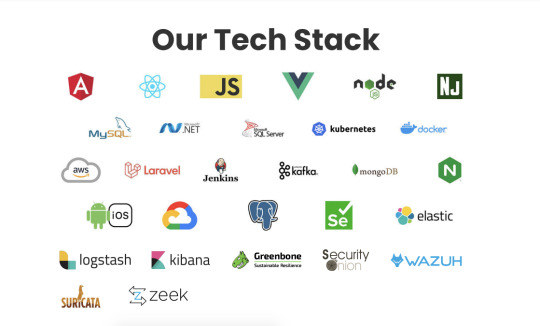
Technology evolves at breakneck speed, and 2024 has brought some game-changing tech stacks to the forefront. Whether you're a developer, a tech enthusiast, or just someone who loves innovation, dive into this engaging guide to explore the hottest tools that are shaping our digital future. Oh, and if you’re wondering how to get started? Stick around to learn how Hexadecimal Software and Hexahome can make your tech dreams come true. 🚀
🌟 MEVN Stack: A Full-Stack Marvel
The MEVN stack (MongoDB, Express.js, Vue.js, Node.js) is making waves with its ability to build dynamic and efficient web applications.
Why it Rocks:
Frontend Power: Vue.js gives you buttery-smooth interfaces and reactive designs.
Backend Simplicity: Express.js handles server-side tasks with elegance.
Database Magic: MongoDB manages massive amounts of data seamlessly.
One-Language Love: JavaScript unifies everything from the backend to the frontend.
Real-world Use:
Think e-commerce apps, social media platforms, or even your next binge-worthy web app.
🚀 Ready to harness the MEVN stack? Let Hexadecimal Software guide you! They even incorporate these technologies into smart homes via Hexahome.
📱 Flutter + Firebase: Mobile Apps Made Easy
This powerhouse duo is a favorite for creating cross-platform mobile apps.
Why You’ll Love It:
Code Once, Run Everywhere: Build for iOS, Android, and the web in one go!
Backend Woes? Fixed!: Firebase handles authentication, databases, and more.
Fast as Lightning: Flutter’s hot reload feature saves hours in debugging.
Beautiful UI: Who doesn’t love sleek, responsive designs?
Where It Shines:
Ideal for chat apps, IoT integrations, or any app that thrives on real-time updates.
👩💻 Work with Hexadecimal Software to bring your app ideas to life. Plus, they integrate seamlessly with Hexahome smart solutions.
🌐 MERN Stack: Building the Future, One App at a Time
The MERN stack (MongoDB, Express.js, React.js, Node.js) is a dream come true for developers seeking power and flexibility.
What Makes It Awesome:
React.js: Create dynamic and reusable UI components.
Express.js: Simplify server-side development with elegant APIs.
Node.js: Enable real-time data updates with event-driven programming.
MongoDB: Handle structured and unstructured data like a champ.
Perfect For:
Social networks, online courses, or data-heavy platforms.
💡 Let Hexadecimal Software transform your ideas into digital masterpieces. They also ensure seamless compatibility with Hexahome for integrated living solutions.
🤖 AI Tech Stacks: TensorFlow & PyTorch for the Win
AI is no longer just a buzzword—it’s the backbone of modern innovation, and tools like TensorFlow and PyTorch are leading the charge.
Why They’re Game-Changers:
Scalability: Train models from small datasets to massive data lakes.
Flexibility: PyTorch’s dynamic graphs make experimentation a breeze.
Pre-built Goodies: Access pre-trained models to save time.
Go Anywhere: Deploy models on mobile or edge devices effortlessly.
Big Impact Areas:
Voice assistants, predictive analytics, or personalized shopping experiences.
🔮 With Hexadecimal Software, AI isn’t just a possibility—it’s a promise. And don’t miss their work with Hexahome for intelligent smart homes.
⚡ AWS Lambda: The Serverless Savior
Why manage servers when AWS Lambda can do it for you? This serverless computing tech is a must for developers aiming to streamline their workflows.
Standout Features:
Only Pay for Use: No idle server costs.
Scale Like a Pro: Automatically adjusts to handle traffic spikes.
Event-driven Brilliance: Easily trigger functions with various AWS services.
Secure & Reliable: Built with enterprise-grade security in mind.
Best For:
Event-driven apps, automated backups, or lightweight APIs.
🛠️ Step into the future with Hexadecimal Software, experts in serverless architectures. Pair that with Hexahome, and you’ve got a match made in tech heaven.
Let’s Build Your Vision Together!
From smart home innovations with Hexahome to cutting-edge applications powered by Hexadecimal Software, the future is brighter than ever. Whether it’s AI, full-stack development, or serverless computing, their expertise ensures you stay ahead of the curve.
💡 Let’s create something amazing—together! Reach out today. 💻
0 notes
Text
How to Choose the Right Mobile App Development Framework: Flutter vs React Native vs Xamarin
If you want to grow your business into additional markets, creating a new app is a smart approach. It could help launch your company into previously unheard-of success. But with so many platforms at your disposal, the development process can get laborious.
It is clear that react native app development and cross-platform mobile development are different from one another. Because cross-platform programming has so many benefits, it is frequently chosen. It allows developers to design programs that function on various platforms. This approach can save time and reduce costs significantly.
This blog compares these cross-platform mobile development platforms.
Flutter:
Flutter is a well-known open-source UI software development option. It was created by Google. This powerful tool helps programmers design applications that look great. It also allows them to build apps that perform exceptionally well. Flutter is versatile. Apps for desktop, web, and mobile platforms can be made by developers.
Pros of Flutter:
Hot Reload: Flutter’s hot reload feature significantly enhances the development process. Developers can instantly notice changes thanks to it.
Outstanding Documentation: Developers often find it easier to get started with Flutter. The reason is its extensive and well-organized documentation.
Growing Community: As Flutter gains traction, the developer community is expanding rapidly. This community is actively contributing to Flutter's ecosystem. They are building a variety of open-source projects.
Cons of Flutter:
High Learning Curve: For developers who are new to the Dart programming language, the journey can be challenging.The reactive programming approach of Flutter increases this learning curve.
Limited Third-Party Libraries: Flutter is an exciting framework for app development. However, it has a smaller third-party library ecosystem. This is not the case with more popular frameworks such as React Native.
Greater download Size: Because the full Flutter engine is included, Flutter applications typically have bigger download sizes.
Xamarin
The bindings for every platform SDK for iOS and Android are available in Xamarin. These bindings are very simple to navigate and utilize. They also offer strong type checking at compile time. To put it briefly, these bindings can aid in the development of more flawless and superior apps. They can also access a variety of tools and libraries. This setup enables the creation of applications that are visually appealing and highly performant.
Pros of Xamarin:
Code Reusability: Developers may share a large percentage of their codebase across several platforms with Xamarin, which speeds up development cycles and lowers maintenance requirements.
Native Performance: Xamarin applications provide exceptional performance and native-like user experiences on all platforms because they are compiled to native code.
Robust Testing: Xamarin provides frameworks and tools for robust testing, enabling developers to create and execute UI tests, unit tests, and other tests to guarantee dependable and high-quality apps.
Cons of Xamarin:
Greater App Size: Because Xamarin includes the Mono runtime and other libraries, its apps may be larger than those of native or other cross-platform solutions.
Performance Problems: Although native performance is the goal of Xamarin, there are situations in which performance might not match native development, particularly in situations requiring complex graphics or calculations.
License Fees: While Xamarin offers a free version for individuals and small teams, commercial licenses would cost more for larger organizations.
Platform-specific quirks: Developers may still need to handle platform-specific quirks even when working with a shared codebase.
React Native
React Native is a cross-platform programming framework for iOS and Android created by a group of Facebook engineers who had worked on ReactJS first. It blends JS interface development with native development. React Native, unlike most other frameworks, does not encapsulate code in WebView. To guarantee that apps appear as native as possible, the framework provides developers with access to native mobile controllers.
Pros of React Native:
Huge Community: Because of its affiliation with React and Facebook's support, React Native has a sizable developer community across the globe. This ensures a wealth of information, tutorials, and libraries from third parties.
Live Reloading: React Native has live reloading, which is comparable to Flutter's hot reload and lets developers view changes right away without having to restart the application.
Code Reusability: Because React Native allows developers to exchange components and functionality across platforms, it facilitates code reuse between online and mobile applications.
Concepts You May Already Know: React Native makes use of concepts and patterns that developers already know, which helps to ease the learning curve for them.
Native Rendering: React Native apps produce a smooth and uniform user experience on all platforms by rendering utilizing native components.
Cons of React Native:
Speed Problems: React Native attempts to provide native-like speed, however when working with intricate animations or huge data sets, performance bottlenecks may occur.
Over-the-Air Updates: Users of React Native must download the complete app in order to receive updates, in contrast to Flutter, which supports smooth over-the-air updates.
Restricted Access to Native APIs: Although React Native offers access to a large number of native APIs, developers can occasionally need to build code specifically for a given platform or rely on third-party libraries.
Conclusion:
It's not easy to select the top cross-platform mobile development framework. Your unique project requirements will determine which option is best. Consider the experience level of your development team as well. Their familiarity with a framework can impact the project’s success. You should also think about your long-term goals.
0 notes
Text
15 Libraries You Should Know if You Build with Dart

Introduction
Front-end developers popularly use Dart language for cross-platform development as Dart makes it faster. Besides having beneficial core features like Ahead-of-Time (AOT) and Just-in-Time (JIT) for enhancing development speed and UI-focused performance, Dart has a rich library that benefits both developers and business owners.
These libraries present appropriate tools and utilities that help developers streamline basic tasks like state management, HTTP requests, or file handling. In this blog, I will introduce 15 essential Dart libraries that every developer should know to make their development experience more comprehensive, faster, and convenient.
Build Using Dart Libraries
A library in Dart is a reusable component of code providing specific functionality or features. Libraries allow modularizing the code, making it easier to reuse, maintain, and test. Libraries can provide utilities for,
Making HTTP requests,
Managing states of the application,
Simplifying authorization,
Assisting with background tasks like fetching data,
Helping with integration tests,
Working with databases, and many others.
A developer can either build their library or use a third-party one available on such platforms as ‘pub.dev’. By importing a library into a Dart project, one can extend its functionality without developing it from scratch.
15 Libraries to look for when building with Dart
1. HTTP
The HTTP package is a lightweight and simple library; it is designed for making HTTP requests easy with Dart. The package allows making all general CRUD (Creare, Read, Update, Delete) operations such as GET, POST, PUT, and DELETE. Moreover, its syntax is as simple as possible. For instance, the library allows interpreting precisely and concisely with REST data, as well as handling responses. The HTTP package is an adequate choice for small projects seeking uncomplicated and concise network interaction.

Explanation: This snippet makes a GET request to fetch a list of posts and prints the response body to the console.
2. Dio
Dio is a powerful HTTP client for Dart that allows developers to easily send network requests and manage responses. It is written with best OOP practices and contains a clear and cohesive API for handling HTTP requests. Dio offers such features as interceptors, cancellation, and retrying but what’s more important it simplifies creating requests on JSON formats and forms. If your application works with a server, then this library will save time for you.

Explanation: This shows how Dio makes network requests and handles responses, similar to HTTP, but with more power and flexibility.
3. Provider
For building Flutter apps, I believe that Provider is mainly used because it is one of the most frequently used libraries for state management. By utilizing Provider, developers can take care of the state across different sections of the application. As such, it is a useful tool for separating a UI from business logic and keeping the code more concise and neat. In addition, this library is highly scalable, which is useful for maintaining and operating complex applications with nested widgets relying on shared data.
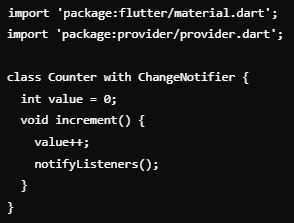
Explanation: This shows how Provider helps manage the state in a Flutter app. The Counter class can notify the UI when its value changes, ensuring reactive updates.
4. Hive
Hive is a high-performance, lightweight, and fast key-value database designed for Dart applications. It is very efficient and provides strong encryption capacities allowing for very secure data storing and management. Thus, the key element for utilizing this database is working with significant tokens, like user identification of credentials. The main advantage of Hive is that the database does not require significant installations or configuration, which means it is very easy to integrate with an application and then delete if not needed.
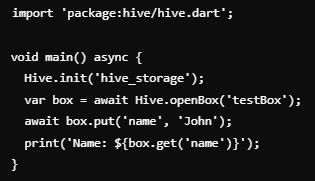
Explanation: This example demonstrates storing and retrieving a key-value pair using Hive for local persistence.
5. GetX
GetX is a very high-performance library not just for state management, but also for navigation and dependency injection in a Flutter app. Its no-boilerplate and high-performance features make it one of the most-used libraries currently. GetX is especially useful in apps requiring multiple layers of UI states and complicated navigation. It is also reactive, meaning it can handle all the service calls and back-end connectivity without any additional support.
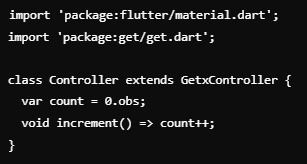
Explanation: GetX allows reactive state management with simple syntax. The count variable automatically updates the UI when changed.
6. Bloc
The Bloc library is an implementation of the Business Logic Component pattern and provides an ordered and structured way of managing the state in Flutter apps. It separates the business logic from the UI, which means your codebase remains clean, modular, and testable. Since the Bloc library uses Streams, it is best suited for applications that need a real-time update of data or have certain complex user flows to be implemented. Bloc is recommended to be used in large applications, where being predictable and scalable is critical.

Explanation: This code shows how the Bloc separates logic from the UI. The CounterCubit manages the state, emitting new values when the counter is incremented.
7. Intl
Intl is a powerful library for internationalization and localization in Dart apps. It provides all the necessary tools for formatting dates, numbers, and currencies depending on the locale, which becomes indispensable when developing global applications. The necessity to manage localized messages at some point is more likely. Along with more than 400 supported locales, the library also helps to customize your app according to users’ time zones, oriental currency format, and even the choice of language.

Explanation: This shows how Intl formats a DateTime object into a specific string format, making it adaptable to different locales.
8. Equatable
Equatable is a simplified way of comparing objects in Dart by overriding “==” and “hashCode” methods automatically. Otherwise, in Dart classes, you would manually implement these methods to create comparison operations between object instances. Since it helps to avoid repetition, Equatable is convenient to use with state management solutions, where object comparisons occur regularly. Particularly it is beneficial when dealing with complex objects having numerous fields that need to be compared.

Explanation: This example shows how Equatable allows easy comparison between objects, without manually overriding equality methods.
9. Json_Serializable
Working with APIs that return JSON is a common way of getting data. However, manually converting this data into Dart objects is not the most efficient process. The JsonSerializable used with annotations is a way to automatically generate code for serializing and deserializing. In other words, you can easily convert the data from Dart objects to JSON and vice-versa with little to no work. This is particularly useful for big applications where working with external APIs is done regularly. It ensures that the process is fully automated and no errors are made in the conversion.
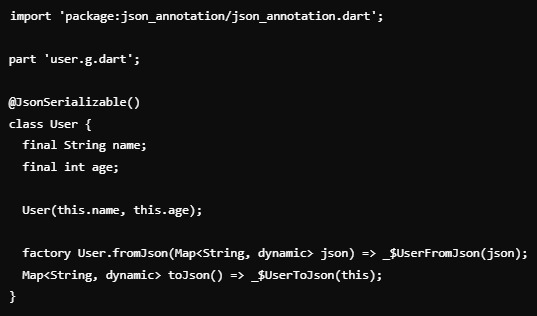
Explanation: Here, JsonSerializable is used to generate code that converts a User class from and to JSON format, making API integration easier.
10. Freezed
Freezed is a code generation library designed for the immutable data classes in Dart. It allows one to create classes that are as simple as they are safe to use, with several features corresponding to union types and pattern matching included. The library can also be seen as a good means of dealing with other libraries like Bloc and Provider, integrating itself well. If you face problems of state management with complex state transitions or simply need immutable objects with the minimum boilerplate, Freeze can be an excellent way out.
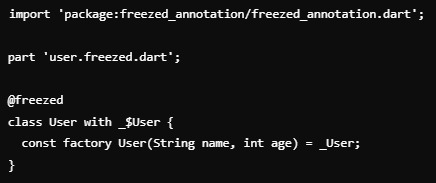
Explanation: This shows how Freezed helps create immutable classes and reduces repetitive code when defining simple data models.
11. Path
The path is an essential cross-platform library that facilitates the process of working with file paths in Dart. The library is designed to work consistently across Windows and Unix-based platforms. Since various applications need file I/O, it is particularly crucial to address this issue, as Windows and Unix-like systems depend on different file path conventions. Path facilitates operations with file and directory paths– joining and splitting paths, as well as normalizing a path to its canonical form.
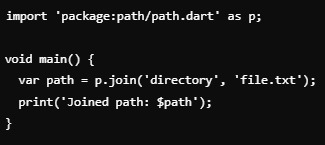
Explanation: This example demonstrates joining file paths in a cross-platform way, ensuring compatibility with different operating systems.
12. Built Value
Built Value is a convenient library for Dart that can be utilized for developing immutable data models. As this tool forces immutability, structures cannot be changed, making it suitable for applications that work with complex data models or API responses. By using Built Value, you can make sure that objects will be unalterable and have types, which contributes to better and more reliable code. In addition, the library supports code generation that reduces the amount of boilerplate material to be used for creating data classes.
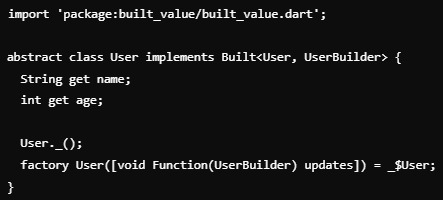
Explanation: Built Value enforces immutability and provides structured ways to create and manipulate objects in a type-safe manner.
13. Fluro
Fluro is a routing or navigator library developed for Flutter which is high-performance and makes navigation to different pages or screens in your app much easier with dynamic route handling, route parameters, and deep linking. It was developed primarily to help in navigation in larger applications with some more complex navigational requirements where you want to have complete control over how routes are defined and handled. This makes it the perfect choice for apps that require custom navigation solutions and deep integration with web-based URLs.

Explanation: Fluro helps handle navigation and routing between different pages, especially useful for complex navigation scenarios.
14. RxDart
RxDart is a perfect library for building apps that depend on interactive or real-time updates. It extends Dart’s standard Stream API with reactive programming principles. This Dart library applies a broad series of operators to work with data streams asynchronously and is perfect for managing complex event-based processes. Both subjects and observables with simple operators, such as map, filter, and merge, are supported. This makes RxDart an excellent tool in different cases. For example, if a developer is writing a chat or dashboard app with real-time updates, it will be the perfect solution.
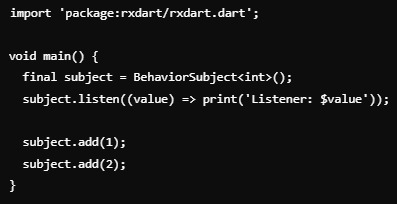
Explanation: RxDart makes handling asynchronous data streams easier. The Behavior Subject emits values that are automatically listened to by subscribers.
15. Firebase
If you need to add any backend service to your app in Flutter, your first choice is likely to be Firebase. It covers all your backend needs- authentication, real-time databases, cloud storage, and push notifications. Using Firebase with Dart is very simple since there is a set of libraries like firebase_auth and cloud_firestore. As a result, you can seamlessly add cloud-based features to your app without writing a single line of backend code. No matter whether you want to build a chat, e-commerce, or social networking app, Firebase has everything you need.
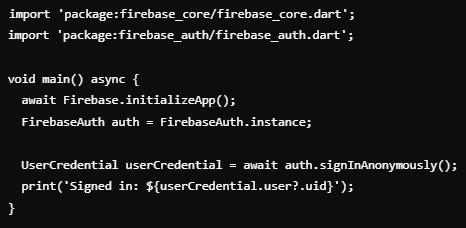
Explanation: This example demonstrates how to initialize Firebase and use its authentication service to sign in a user anonymously.
FAQs
1. Which Dart libraries are used in web development?
A few Dart libraries for building web apps are HTTP, json_serializable, intl, firebase, and many others. These libraries are used for fetching data from APIs, converting between Dart objects and JSON, formatting for dates, and currencies handling language translation, and securing authentication respectively.
2. Which Dart libraries are used in mobile app development?
The following Dart libraries are used in mobile app development among many others - GetX, Firebase, Hive, HTTP, and Provider. The provider helps in managing the state of the mobile applications, GetX simplifies navigation within apps built on Flutter, HTTP helps you manage network requests, Hive locally stores high-value objects and Firebase assists with user authentication and real-time updates.
3. What is the Dio library in Dart?
Dio is a popular HTTP client library in Dart. It is primarily used for simplifying networking requests like performing CRUD operations (Create, Read, Update, and Delete). Dio's core functionalities like interceptors, error handling, timeouts, file uploading, forming data, etc make it highly preferred in Dart projects.
Conclusion
There are plenty of libraries in the Dart ecosystem to create everything from mobile to web to desktop applications. If you are building user interfaces, managing the state of your application, or working with HTTP requests or files, these libraries described in this blog will help you speed up the development process. Using these libraries will allow you to concentrate on creating new features without reinventing the wheel.
#DartLibraries#DartProgramming#FlutterDevelopment#DartTools#DartCommunity#OpenSource#ProgrammingTips#DeveloperResources#DartLanguage#LearnDart
0 notes
Text
Building Scalable Flutter Apps with MobX: Efficient State Management for Dynamic UIs

Building scalable and efficient Flutter apps requires mastering state management, a vital part of handling dynamic data and user interactions. As your app grows, so does the complexity of managing its state, which can impact performance and development speed. Choosing the right state management approach is essential to ensure smooth user experiences and maintainability.
Enter MobX, a powerful reactive state management library that allows you to effortlessly manage app state with minimal boilerplate code. MobX enables Flutter developers to handle complex UI updates by reacting to changes in application data in real-time, ensuring that only the necessary parts of the UI update when needed.
This blog will explore why MobX is the perfect choice for building scalable Flutter apps. You’ll learn the basics of MobX, how to integrate it into your Flutter project, and best practices for creating dynamic, responsive UIs. Whether you're a seasoned developer or new to Flutter, this guide will help you implement efficient state management using MobX.
What is MobX?
MobX is a powerful state management library designed to simplify how you manage and react to state changes in your Flutter applications.

Observables: These are state variables that MobX monitors for changes. When there are observable updates, MobX tracks these changes to ensure that the UI reflects the latest state.
Actions: Actions are functions that modify observables. They encapsulate the logic for updating the state, making it easier to manage complex state changes.
Reactions: Reactions are automatic responses to observable changes. They help keep your UI in sync with the state without manually updating it.

In comparison to other state management solutions like BLoC, Redux, and Provider, MobX offers a more declarative approach. While BLoC and Redux can involve significant boilerplate code and complex setup, MobX’s reactive nature allows for simpler, more intuitive state management. Provider is easier to use but lacks some of the advanced reactivity features MobX provides.
Why choose MobX for Flutter apps? Its reactive system ensures that your app remains responsive and efficient as it scales, making it a standout choice for dynamic UIs.
Benefits of Using MobX in Flutter
If you’ve ever struggled with state management in Flutter, you know how critical it is to choose the right tool. MobX offers a range of benefits that make it an excellent choice for building scalable, high-performance Flutter apps.
1. Reactive State Updates: With MobX, your UI responds automatically to changes in the state. This means less manual intervention and a more fluid, real-time user experience.
2. Simplified and Clean Architecture: MobX reduces boilerplate code by focusing on observables and reactions. This results in a cleaner, more maintainable codebase that’s easier to understand and debug.
3. Efficient Handling of Complex UI Updates: MobX’s fine-grained reactivity ensures that only the parts of your UI that need to update do so, optimizing performance and reducing unnecessary renders.
4. Improved Performance for Dynamic Applications: By minimizing unnecessary updates and handling complex interactions gracefully, MobX enhances the performance of dynamic, data-driven apps.
Adopting MobX for state management streamlines your development process and elevates your app’s performance and scalability.
Read more: https://www.blup.in/blog/building-scalable-flutter-apps-with-mobx-efficient-state-management-for-dynamic-uis Flutter Learning Roadmaps: https://www.blup.in/blogs
#flutter app development#app development#app developers#appdesigners#custom software development#mobile app development#web app development#mobile application development#flutter app developers#MobX#programming#coding#software engineering#information technology#software#uidesign#web developers#state management
1 note
·
View note
Text
Why Use Flutter for Mobile App Development?
Today, having a mobile app for everything has made it easier to fast-track things.
Do you know, that people check their phones 58 times per day? And almost 52% of checking their phones (30 per day) occur during work hours. Mobile apps have taken the market by storm. Thus businesses and developers seek solutions that help them build a strong presence in the mobile app industry.
Flutter has emerged as a popular choice for cross-platform mobile app development to cater to their growing demand. Flutter is powering top brands like eBay, Grab, GPay, Groupon, and more today.

Flutter’s popularity is its simplicity, fast development cycles, and flexible UI. it can benefit businesses in several ways especially when they want to build a strong mobile industry presence.
Let’s understand why Flutter is becoming a go-to framework for mobile app development.
What is Flutter?
Flutter is a popular cross-platform mobile app development framework that Google created for its internal usage. Later, it was available for everyone’s use. In less time, Flutter has gained immense popularity.
Over the years Flutter has improved and has made mobile development easier with several plugins, widgets, developer tools, and more.
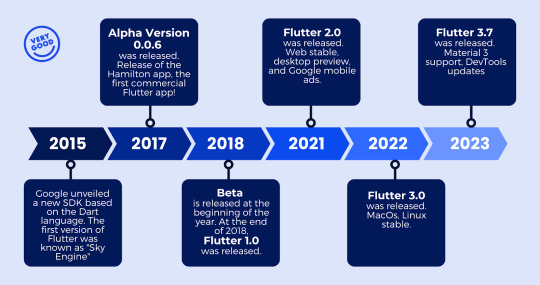
Source- https://verygood.ventures/blog/flutters-history-so-far-all-the-biggest-milestones
Several giants are leveraging Flutter to stay ahead with next-level mobile app development.
Brands leveraging Flutter
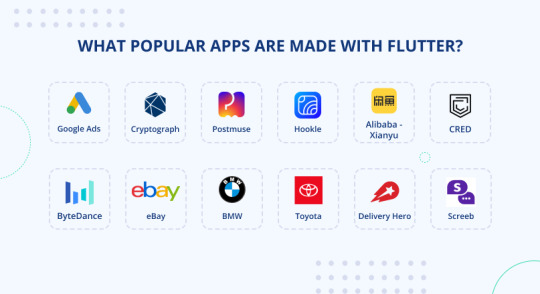
Reasons to Choose Flutter for Mobile App Development
1. Cross-Platform Development
Flutter is a cross-platform platform. It simply means, that developers only have to write a single codebase that will efficiently run across mobile devices and OS. It ensures the same native look and feel. It not only saves developers time and effort but also reduces significant development costs, making. Thus it is a cost-effective solution for businesses with limited budgets.
2. Native Performance
Flutter uses Dart, a fast and object-oriented programming language, which compiles native code. This means that Flutter apps offer native performance and can take full advantage of the underlying platform's capabilities.

Source
Unlike other cross-platform frameworks that only rely on web views or JavaScript bridges, Flutter renders UI components directly to the canvas, offering smooth animations, fluid interactions, and excellent performance. From scrolling through a list or navigating between screens, it offers a high level of responsiveness to users.
To build native apps that execute well across platforms, you must hire a Flutter App Development Company.
3. Rich and Customizable UI
Another reason that makes Flutter preferable to 46% of developers is its rich set of pre-designed widgets for high customization and flexible designs. Developers can create engaging user interfaces that adhere to the native platform's design guidelines.
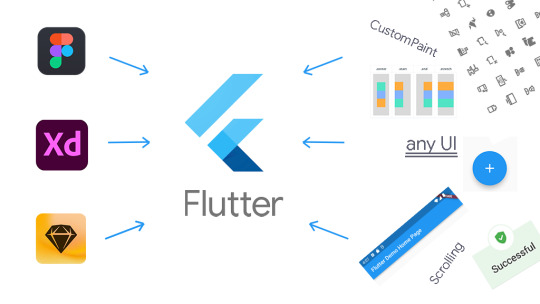
Apart from the customizable UI, Flutter has a reactive architecture that allows developers to integrate animations, gestures, and effects for visually engaging user experiences. Whether it's Material Design for Android or Cupertino for iOS, Flutter provides the tools and components to create pixel-perfect UIs that look and feel native on each platform.
4. Fast Development Cycle
Another significant reason for Flutter's amazing results is the hot reload feature. It helps developers to make changes to the code and see the results instantly without restarting the app. This iterative development cycle speeds up the development process and improves team collaboration.
It allows developers to experiment with different UI layouts, tweak animations, or fix bugs on the fly, while maintaining the app's state. This rapid feedback loop helps them deliver the app in less time, increasing time-to-market.
5. Strong Community Support
Flutter is supported by an active community of developers and contributors who aim to improve Flutter’s experience for all. From official documentation and tutorials to third-party packages and plugins, developers can access several resources and tools to build better apps faster.
Also read: flutter web tips
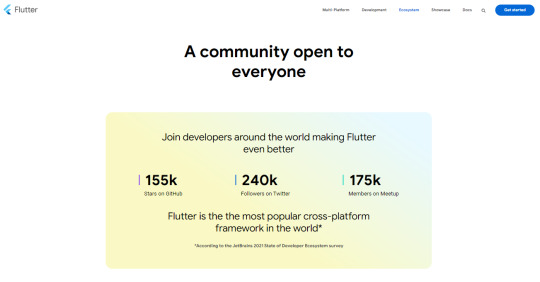
Hire Flutter Developers with OnGraph
There is no doubt about Flutter’s capability. It not only helps developers simplify their development experience but also guarantees business growth and success. If you are looking to expand your brand visibility with an exceptional mobile app, then Flutter is your way to go.
To elevate your mobile app experiences, connect with OnGraph for advanced Flutter App Development Services.
Why choose OnGraph?
Faster time-to-market
100% customizable designs
Cross-platform development
15+ years of expertise
Content Source URL: https://dev.to/sophiaog/why-use-flutter-for-mobile-app-development-3gp
#Flutterformobileappdevelopment#Flutterapps#mobileappdevelopment#Flutterbestpractices#Flutterperformance#WhyisFlutterbetterforappdevelopment#WhatisthemainpurposeofFlutter#WhyshouldmobileappstartupschooseFlutter#IsFluttergoodforappdevelopment
0 notes
Text
hire flutter app developer india
The app development industry is on the rise & as a leading flutter App development company, Samyak Infotech can easily handle your diverse Flutter projects. Be it an iOS, Android, or web application, our Flutter developers can help you get a high-performing, user-friendly & functional app.
Flutter is an open-source UI software development that can get you effective results from a single codebase. Flutter uses a reactive framework and a rich set of pre-designed widgets to create stunning user interfaces.
So if you are using any mesmerizing app, after using a Flutter app, your users won’t be knowing it was made with Flutter.
0 notes
Text
The Future of Hybrid mobile App Development: 5 Frameworks to Watch
There are various types of mobile apps such as Native, Hybrid, Web, and Progressive Web Apps. Out of all, having a hybrid mobile app has the most benefits since it has characteristics of both Native and Hybrid apps. Hybrid app frameworks are the ones that make it possible to create the most versatile and most advanced app types and in this blog, we will discuss the top 6 hybrid app development framework and their benefits and if you become convinced of the benefits of hybrid apps, we suggest you to hire dedicated hybrid mobile app developers to develop a best hybrid mobile app for your business.

Top 5 Frameworks to Watch while Developing a Hybrid App
1. React Native
React Native is one of the most popular and effective frameworks for hybrid apps. It was developed by Facebook in 2015. React Native is written in JavaScript, Java, C++, Objective-C, and Python and is used by both iOS 9+ and Android 4.1+. The popular apps using React Native apps are Uber Eats and Skype.
There are various advantages offered by React Native such as features like live and hot reloading, intuitive modular architecture, 90% of the code can be reused across iOS and Android, and a Quick installation process, among others.
2. Flutter
Flutter is the only mobile SDK that provides reactive styles without any Javascript bridge. It was released in 2017 and developed by Google. It uses Dart language and is used by both iOS 9+ and Android 4.4+. The popular apps using Flutter are Hamilton and Alibaba.
Flutter offers benefits like fast code writing, a faster testing process due to a single codebase, and rich widgets that can be customized, interactive, and easily adaptable by different screens. Get help from hybrid app development services to get a hybrid app using the Flutter framework.
3. Ionic
Ionic has a powerful front-end Software Development Kit (SDK) that helps you enhance the functionality of an app. It helps in integrating an app with any Javascript framework such as Vue, React, and Angular. It was released by Drifty in 2013 and is written in JavaScript. It is backed by iOS 8+ and Android 4.1+ and apps such as Sanvello and JustWatch are using it.
The benefits of Ionic are it enables code once and runs it everywhere, enables integration with high-end plug-ins, is easy to adopt due to a low learning curve, and is easy and convenient to test.
4. Xamarin
Xamarin is one of the best apps used for cross-platform apps for iOS, Android, and Windows Phone in C# with Visual Studio. Xamarin uses the .NET platform and helps in continuous developer support, wide learning opportunities, and full technical backing by Microsoft. It was released in 2011 by Microsoft and written in C# language. Both iOS 9+ and Android 4.4+ support it and platforms such as Alaska Airlines, and Outback Steakhouse.
The benefits of Xamarin are it can share up to 90% of its codebase across major platforms, is easy to update, test, and maintain, and provides testing tools. You can get help from developers for hybrid mobile applications to incorporate Xamarin for mobile app development.
5. NativeScript
NativeScript helps in developing apps for mobile using JavaScript or TypeScript. This framework gives the experience of native user experience to each mobile OS platform. It was released in 2014 and was developed by Progress Software (formerly Telerik). It has been written in JavaScript, and TypeScript and backed by platforms such as iOS 9+, and Android 4.2+. Popular apps such as Daily Nanny, and Regelneef, among others.
The benefits offered by NativeScript are developer-friendly CLI (Command Line Interface), direct access to all iOS and Android APIs, use of XML-Esque-based markup language, and easy and quick app debugging.
Stay Updated in the World of Technology Using Hybrid App Development Framework!
Using the discussed hybrid app development framework can help your business grow rapidly. Having a hybrid app increases your reach and makes it convenient for your target audience to use and interact with your business. We suggest you consult with hybrid app development services to understand which framework is most suitable for your business and get a perfectly developed hybrid app for your business!
#hire dedicated hybrid mobile app developers#hybrid app development services#developers for hybrid mobile applications
0 notes
Text
Learn Building Cross-Platform Magic with Google's UI Toolkit and creating unique apps with flutter app development

In today's fast-paced digital landscape, mobile applications have become an integral part of everyday life, facilitating communication, productivity, entertainment, and more. Flutter, Google's open-source UI software development kit, has emerged as a powerful tool for building cross-platform mobile applications with a single codebase. Offering a rich set of customizable widgets, robust performance, and seamless integration with popular development tools, Flutter empowers developers to create stunning, feature-rich apps for iOS, Android, web, and desktop platforms
Project Planning and Setup
Before diving into the development process, thorough project planning and setup are essential for laying a strong foundation. This phase begins with a clear definition of the app's purpose, identifying the problem it aims to solve and the target audience it intends to serve. Key features and functionalities are outlined to guide development efforts effectively. Technical specifications are then established, including the selection of the Flutter version and Dart SDK, as well as decisions on supported platforms such as iOS, Android, web, and desktop. Development tools like IDEs such as Android Studio or VS Code are chosen to streamline the coding process. With the project's goals and technical requirements in place, the project structure is set up, including the initialization of a new Flutter project and the organization of directories to maintain code cleanliness and scalability. Dependencies are configured in the pubspec.yaml file to integrate external libraries and resources seamlessly. This meticulous planning and setup phase ensures that the development process starts on a solid footing, setting the stage for efficient and successful app creation.
Feature Development
With the project planning and setup completed, the focus shifts towards implementing the core features that define the app's functionality and user experience. This phase involves translating the conceptualized features into tangible components and functionalities. Authentication mechanisms, such as Firebase Auth or OAuth, are integrated to ensure secure user access and data protection. In flutter app development Data storage solutions, including SQLite, Firebase Firestore, or Hive, are implemented to manage and persist user data effectively. Network request handling, facilitated by libraries like Dio or Http, enables the app to communicate with external servers and APIs, facilitating data exchange and synchronization.
Performance Optimization
As the feature development phase progresses, it's crucial to prioritize performance optimization to ensure the app delivers a smooth and responsive user experience across various devices and usage scenarios. Code optimization techniques are employed to identify and address inefficiencies in the codebase, improving overall execution speed and resource utilization. This involves refactoring code to eliminate redundant operations, minimize unnecessary computations, and optimize algorithmic complexity wherever possible. By streamlining code execution, the app becomes more efficient and responsive, enhancing user satisfaction and retention.
Crafting Beautiful UIs with Flutter
Flutter's UI capabilities are second to none, allowing developers to create visually stunning interfaces that captivate users. Leverage Flutter's extensive widget library to design intuitive layouts and interactive elements. Whether you're creating custom animations, implementing complex navigation patterns, or designing responsive interfaces for different screen sizes, Flutter provides the tools and flexibility you need to bring your app's UI to life.
State Management in Flutter
Effective state management is essential for building robust and scalable Flutter apps. With Flutter app development reactive framework, you have several options for managing state, including Provider, Riverpod, Bloc, Redux, and GetX. Choose the approach that best fits your app's architecture and complexity, ensuring smooth data flow and efficient state updates throughout your app.
Optimizing Performance in Flutter
Performance optimization is critical for delivering a snappy and responsive user experience. Employ code optimization techniques to streamline your app's execution, minimize UI rendering times, and optimize network communication. By reducing app size, minimizing latency, and leveraging Flutter's performance optimizations, you can ensure your app performs flawlessly across various devices and usage scenarios.
Testing and Deployment
Before releasing your Flutter app to the world, thorough testing is essential to catch bugs and ensure a seamless user experience. Write unit tests, widget tests, and integration tests to validate your app's functionality and behavior. Once tested, prepare your app for deployment by generating APKs or IPAs for Android and iOS, respectively. Follow platform-specific guidelines for publishing your app to the Google Play Store or Apple App Store, and don't forget to gather user feedback to iterate and improve your app over time.
Conclusion
Flutter app development opens up endless possibilities for building cross-platform apps that delight users and drive engagement. With its intuitive development experience, powerful UI capabilities, and unmatched performance, Flutter has become the go-to framework for developers worldwide. Whether you're a seasoned developer or just starting your Flutter journey, mastering this versatile toolkit will undoubtedly elevate your app development game and unlock new opportunities in the ever-evolving world of mobile and web development.
0 notes